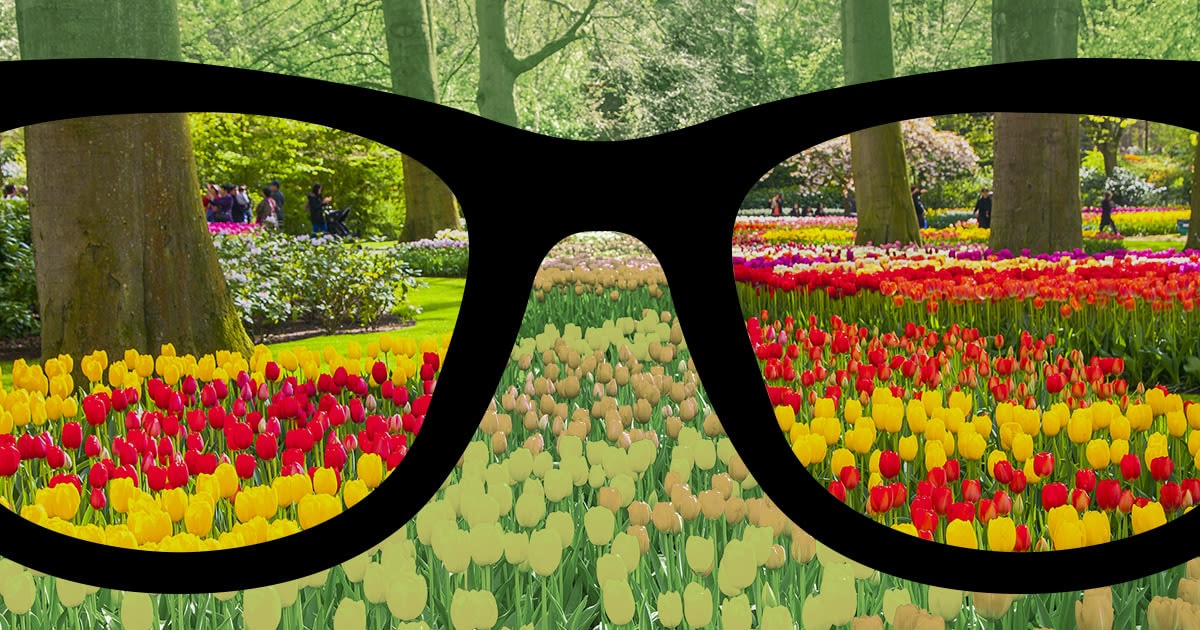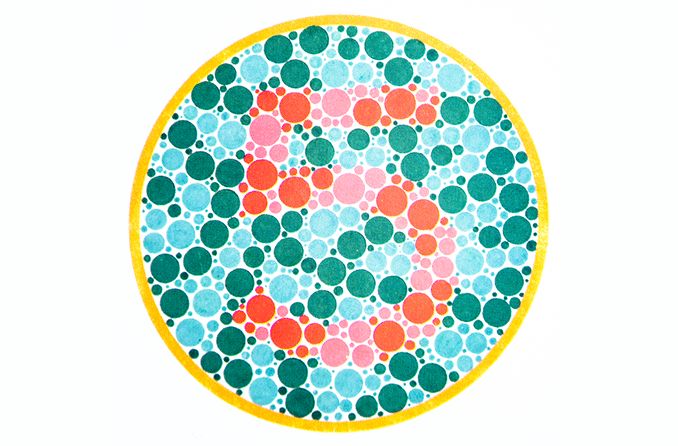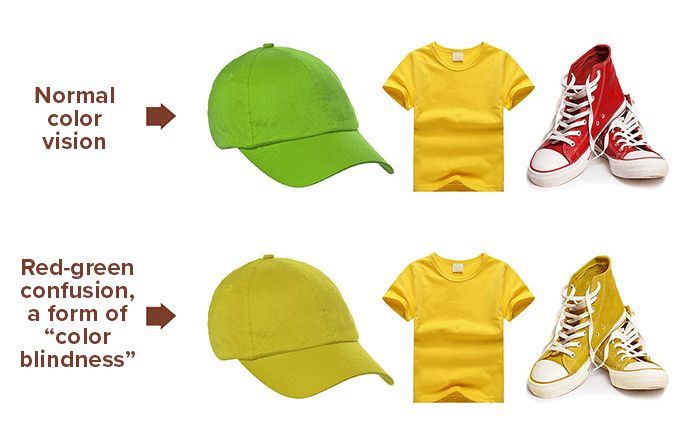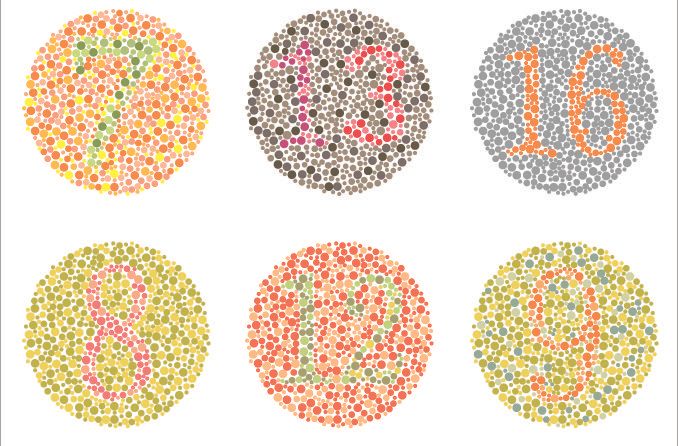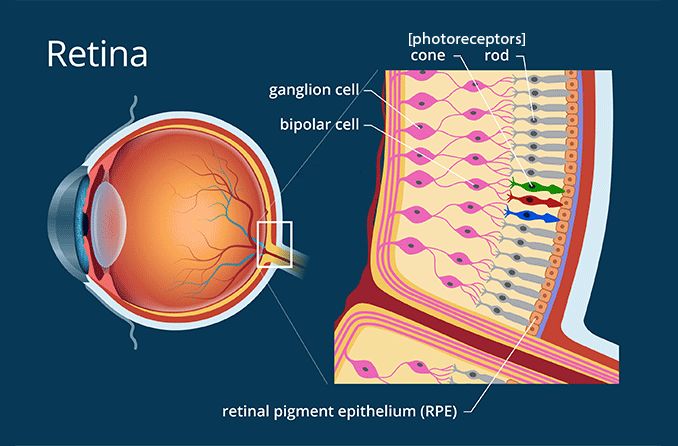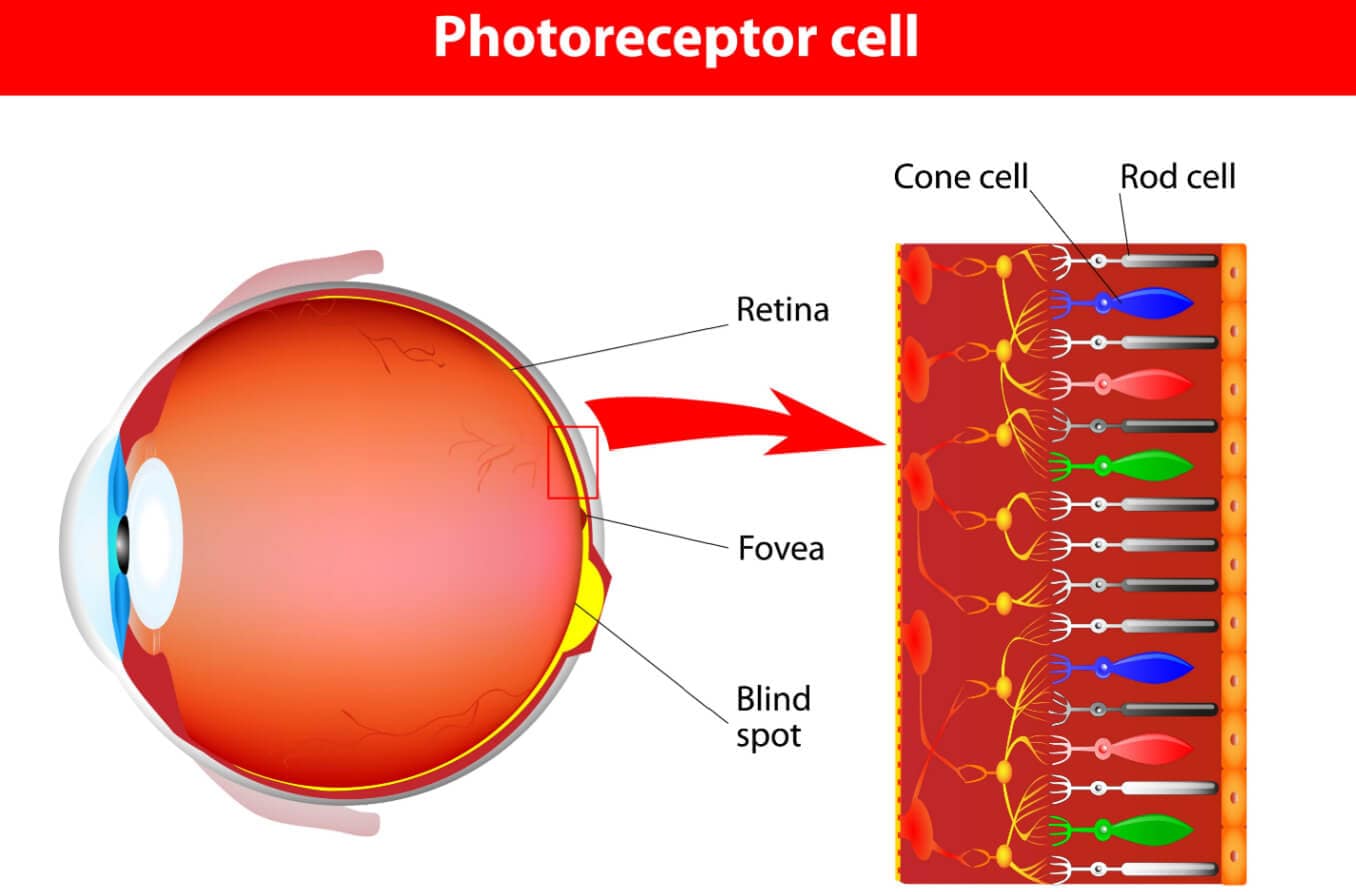The question of how many types of color blindness exist can be confusing. The categories are nested, and some versions that are designated as distinct conditions manifest in similar ways.
To make navigation of the topic even more interesting, variations can be further divided into inherited and acquired types of color blindness. The physiological manifestations of each are the same, though.
Let’s break it down, step by step.
What are the different types of color blindness?
There are seven official diagnoses of color blindness: four different types of color blindness fall in the red-green category, two are in the blue-yellow spectrum and one version describes a type of vision completely lacking in color.
To understand the multiple types of color blindness that exist, it can be helpful to briefly review the basic mechanisms of human vision.
Our eyeballs have two kinds of photoreceptors in the retina that are designed to absorb light. Named after their shapes, they are called rods and cones.
Rods are highly sensitive. They are the reason your eyes will adjust in a dark room, allowing you to see basic shapes. The human eye has eighteen times more rods than cones.
But the cones are what give us fine detail and color. They work best in bright daylight. All types of color blindness have to do with diminished (or absent) functionality in the cones.
The human eye contains three different types of cones. S-cones (short-wavelength absorbing cones) help us see blue, M-cones (medium-wavelength absorbing cones) reveal green and L-cones (long-wavelength cones) interpret red light. The absence of any of the three types of cones is what accounts for different types of color blindness.
With just those three light sensitivities, we can see literally thousands of colors. Individuals who have all three types of cones working at full capacity are called trichromats (tri meaning three and chroma being the Greek word for color). Likewise, normal vision can be referred to as trichromacy.
The different types of color blindness are generally divided by whether the vision defect is inherited or acquired. Inherited types of color blindness are grouped by red-green and blue-yellow, along with the more rare monochromacy (total color blindness).
Similar distinctions exist among the acquired forms of color blindness. Though the causes may be different, the resulting symptoms (color blindness of some degree of severity) are ultimately caused by deficiencies in the cone photoreceptors.
Inherited types of color blindness
Most people who have trouble seeing various spectrums of light have what is called inherited color blindness. The genes that code for correct cone function, which are passed down from their parents, have an error. This is why color blindness tends to run in families.
Anomalous trichromacy
Color blindness results from loss or damage to one or more of the cone types in the retina.
The most common types of color blindness in humans fall under the heading of anomalous trichromacy. That is to say that one of the three cone types (red, green or blue) in the individual’s eyes isn’t functioning as expected.

People who are color blind can only see certain colors, depending on which type of color blindness they have.
Red-green
The types of red-green color blindness fall into four different categories.
Protanopia (aka red-blind) – Individuals have no red cones.
Protanomaly (aka red-weak) – Individuals have red cones and can usually see some shades of red.
Deuteranopia (aka green-blind) – Individuals have no green cones.
Deuteranomaly (aka green-weak) – Individuals have green cones and can usually see some shades of green.
Ultimately, the different types of red-green color blindness all result in the individual seeing a world the rest of us would describe as murky green with hints of blue and yellow. Browns, oranges and reds are easily confused, and pale shades in general are difficult to distinguish.
Blue-yellow
Blue-yellow color blindness is less common. The two types of color blindness in this category both make it difficult to tell the difference between blue and green, as well as yellow and red. There are two types of blue-yellow color blindness:
Tritanopia (aka blue-blind) – Individuals have no blue cones.
Tritanomaly (aka blue-weak) – Individuals have blue cones and can usually see some shades of blue.
All six of these types of color blindness stem from one of the three cone types not functioning to some degree. Though people with anomalous trichromacy may have trouble selecting ripe fruit or reading traffic lights, most colorblind people adapt to live normal lives. Monochromacy, on the other hand, can be quite challenging.
Monochromacy (achromatopsia)
Achromatopsia occurs in only one in every 33,000 people. People with monochromacy see no color at all. For these individuals, the world exists in black and white, much like an old-time television. The concomitant light sensitivity often transforms everyday tasks into difficult chores. Individuals interested in learning more should visit AchromaCorp.org and consider joining the Achromatopsia support group on Facebook.
Tetrachromacy
It’s interesting to note that some women actually have a fourth type of light-absorbing cone. As many as 12% of women may have “super color vision,” the fourth cone allowing them to see 100 times more colors than the rest of the population.
Acquired types of color blindness
Color blindness is not always inherited. It can be caused by environmental factors and can affect each eye individually to different degrees. The actual categorizations (as outlined above) are the same, but the foundational causes are quite different. Some ways color blindness can be acquired are:
Age – A subtle blue-yellow color blindness can develop with age. Quite simply, the lens becomes less transparent, affecting how much light reaches the cones.
Alcohol consumption – Reduced color discrimination can be a symptom of alcoholism, with blue-yellow being particularly affected.
Brain trauma – Head injury or stroke can sometimes (though rarely) result in color blindness.
Chronic illness – Individuals suffering from serious illnesses such as Alzheimer’s disease, leukemia, Parkinson’s disease and others may develop color blindness in different forms.
Environmental chemicals – Even at low levels, carbon disulfide and lead can cause color blindness.
Most people who become colorblind (as opposed to those who are born with the condition) retain the ability to perceive some colors, but symptoms may vary over time, and in some cases the condition can progress into more serious types of color blindness, such as monochromatism.
How common is color blindness?
The non-profit Colour Blind Awareness has compiled statistics on types of color blindness the world over. According to their research, about 8% of men and 0.5% of women worldwide have some sort of color vision deficiency, though the numbers tend to shift depending on a population’s heritage. Primarily white (Caucasian) regions, such as the Scandinavian countries, tend to have higher rates of all types of color blindness (in the range of 10-11% for men), while sub-Saharan countries have almost no incidents of color blindness at all.
The most common types of color blindness are those in the red-green category. In the colorblind population, deuteranomalous (or green-weak) vision is by far the most prevalent. The official breakdown is as follows:
Protanopes 12.5%
Protanomalous 12.5%
Deuteranopes 12.5%
Deuteranomalous 62.5%
Tritanopes and tritanomalous individuals (with impairment in the blue-yellow spectrum) experience much more rare types of color blindness. By some estimates, this type of color blindness affects only one out of every 10,000 people. It’s also interesting to note that blue-yellow color blindness is not tied to gender in the same way as red-green color blindness. Men and women are affected equally.
Types of treatment for color blindness
Individuals who have acquired one of the different types of color blindness due to illness or injury may be able to improve their vision by addressing the underlying condition, but every case is unique.
For individuals who are born with a color vision deficiency, treatment options are much more elusive. In order to truly cure color blindness, science will need to make significant advancements in gene therapy.
So far, some promising research has led to successful treatment in dogs, mice and sheep. One study at the University of Washington has even used gene therapy to successfully treat red-green colorblind monkeys. However, trials have not yet begun on human subjects.
That said, there are some products, such as colorblind contacts or colorblind glasses, that might help with color blindness. In 2010, eyeglasses called EnChroma glasses came on the market. Promotional videos showed colorblind people putting on the glasses and seeing the world in full color for the first time, but consumers are cautioned to consider what types of color blindness EnChroma can actually address.
No accessory can fix color blindness. What the EnChroma glasses do is increase color contrast. Some individuals have found that wearing the glasses can make a significant difference in their vision, but the effect comes at a price. EnChroma glasses range from $250 to $350. It should be noted that at least one study found the EnChroma glasses were no more effective than inexpensive high-contrast hunting glasses.
High-tech help
There are a variety of apps that can help colorblind people navigate the world a little more easily.
An app called Color Blind Pal aims to help people with color blindness see the colors on their screens more clearly. It includes features that describe colors, such as “pink” as well as saturation, hue and value. It can isolate colors to assist in differentiation. It can even overlay a pattern (think stripes) on a designated color.
The Dalton Lens app is specifically aimed at helping colorblind people interpret graphs and charts. By hovering a mouse over a color, the reader gets a description of the color. Color filters can be applied to help differentiate between colors that may seem similar.
The app Sim Daltonism allows non-colorblind individuals to see images through the filter of various vision impairments. Curious what your office looks like to those with deuteranopia? You can see it with just a few clicks. While not directly intended for use by people with color vision differences, the app allows developers to design websites that can still be viewed and understood by people without a normal range of color vision. It is an excellent tool for assessing what types of accommodations could be considered for someone with color blindness in the workplace.
Workplace challenges for colorblind people
In general, individuals with color vision differences can lead perfectly normal lives, but there are some professions that may be challenging or downright dangerous without the ability to distinguish between different hues.
Some jobs in the military, police, fire or aviation industries are generally not an option for colorblind individuals due to the importance of colored signals and hazard signifiers. Hospital technicians and pharmacists are likewise reliant on important, color-coded labeling. Painters, textile manufacturers, interior designers and fashion professionals will face certain challenges inherent in their line of work, but may be able to find ways to manage the differences in their vision.
There will likely be challenges in the workplace even for individuals who do not rely on color to do their job. Due to our cultural acceptance of green as an indicator of “good” and red as “bad,” many signs tend to use this dichotomy. However, these are precisely the two colors that the majority of colorblind people cannot see. Employers should keep in mind that 10% of their workforce is likely colorblind and strive to keep their signage clear and easy for everyone to read.
Get tested
If you think you might be colorblind, there are resources available to you. The National Eye Institute has a wealth of information on color blindness as well as other resources for eye and vision health. You can also check out our article on Tips for better living with color blindness.
Many color blind tests can be found online. Because exact color representation is essential for the accuracy of any color blind test, results from online color vision screening tests are suspect. For the most accurate results, see your eye doctor to take a color blindness test administered by a trained professional using standardized testing materials under proper lighting.
READ MORE: Color blind tests: Do you see colors as they really are?

